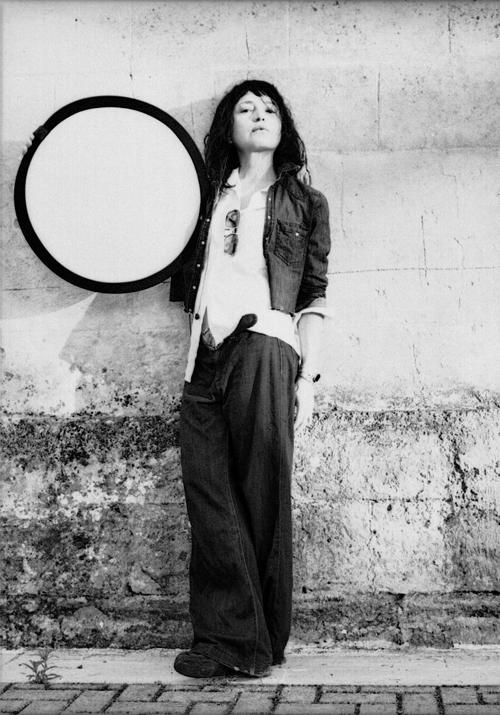Not long after she returned home to Europe last October, Tucson chanteuse Marianne Dissard tiptoed back into her old filmmaker life.
That’s what she used to do before she found her unique singing voice, which changed her life trajectory when she first came to Tucson in the early 1990s.
At home in Ramsgate, Kent, on the southeastern-most tip of the United Kingdom, Dissard fixed her lens on a whole world of ordinary — from kids skateboarding to old men staring out at the boats docked for the winter — that she has captured in the moment, living the best life they can in these haunting COVID-19 times.
“In these photos, stories and history, and our future. This is England right now,” Dissard said in an email interview to talk about her just released cover of Ritchie Valens’s “Come On, Let’s Go!” “These small daily ‘nothings’ I photograph testify to the momentous days we are living.”
Dissard spent most of 2020 in Tucson more by circumstance than choice. She came home in late 2019 for what was supposed to be a couple of months to make repairs on her Tucson home. But then COVID-19 happened and air travel was restricted so she was grounded.
She spent her time in Tucson working on her west-side home and her music. In addition to the Ritchie Valens cover, Dissard released a cover of Phil Ochs’ 1969 protest song “The Scorpion Departs But Never Returns” in April and one of Janis Ian’s “At Seventeen” in June. All three will be part of her forthcoming album of covers set to be released in July that also will include covers of songs by Scott Walker, Carly Simon and Jimmy Webb. She worked on the album with English producer Raphael Mann and saxophonist Terry Edwards, as well as Tucsonans Naïm Amor — her ex-husband — Marco Rosano, Vicki Brown and Thøger Lund.
For the Valens cover, Dissard transformed the song from an exuberant rocking romp to a sultry come-hither seduction that was inspired by Tucson’s summer of 2020.
“We had a very hot Tucson summer as you remember all too well. Just like everyone, I was cooked up inside my house on the west side and sucking on fire smoke. I don’t own a car (refuse to) so I’d be out cycling before dawn, up to Gates Pass on my more courageous days or along Silverbell north to Marana and back (the easy route),” the 51-year-old French native recalled. “Save for the delivery folks, I rarely saw anyone for weeks at a time. My return to Europe had been delayed from March to some mysterious future date. And ... I was pining for a man many time zones away who was very much in my dreams. It was a zany summer, when dreams and ‘reality’ really started becoming one. So, of course, when I bumped into Ritchie Valens’ song, I immediately responded to what in truth undergirds all the best 1950s teenage rock: sexual tension that arises and finds expression within a somewhat circumstantially-constricted world.”
Dissard, who also is working on her second novel, posts her Rumsgate photos daily on Instagram (instagram.com/mariannedissard) and is compiling the best photos for an online exhibit. In addition to photos of people and places, her project glimpses the gentrification of the small town by London weekenders, who own second homes in the town of about 40,000.
“If I could draw a parallel to the Tucson we remember, I’d say it feels like I’m taking photos of downtown Tucson in the early 90s, pre-gentrification,” she explained, adding that like Tucson of 30 years ago, Rumsgate is experiencing a new infusion of development that is changing the character of the town that has one of the largest marinas on England’s south coast.
Later this year, Dissard’s photo project will be part of a public exhibit that she hopes will “spark curiosity and self-examination” in her community.
Ramsgate, her European home since 2017, and most of the UK is in lockdown, with residents allowed only to venture out for exercise and essential shopping. Dissard, who lived in Tucson for 20 years after arriving here in 1994 to make the Giant Sand documentary “Drunken Bees,” takes her camera when she “exercises,” documenting life on the streets of the quaint seaside town. The project has allowed her to find “a world within one square-mile of Ramsgate.”
“Young, old, rich and destitute, old Kent, new immigrants, and ‘Down-From-London’ gentrifiers ... looking stoic, resigned, angry, scared, festive despite, hopeful, happy, too, and beautiful,” Dissard said of the people she encounters. “Few are masked. Not posing. In my photos, they look like themselves.
“It’s very odd being surrounded by people after months in Tucson where social interactions were few and far,” she added. “I walk around all day in a physical space (those streets) that was built around people, not cars. Does it make me feel more human? I don’t know yet. Just different. But the essence of this year remains: distance, separation, fear of the other, doom and gloom and hope and life all tangled in these bodies and eyes I see from fairly up close and personal nowadays in England, my new or next home.”





